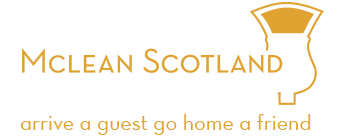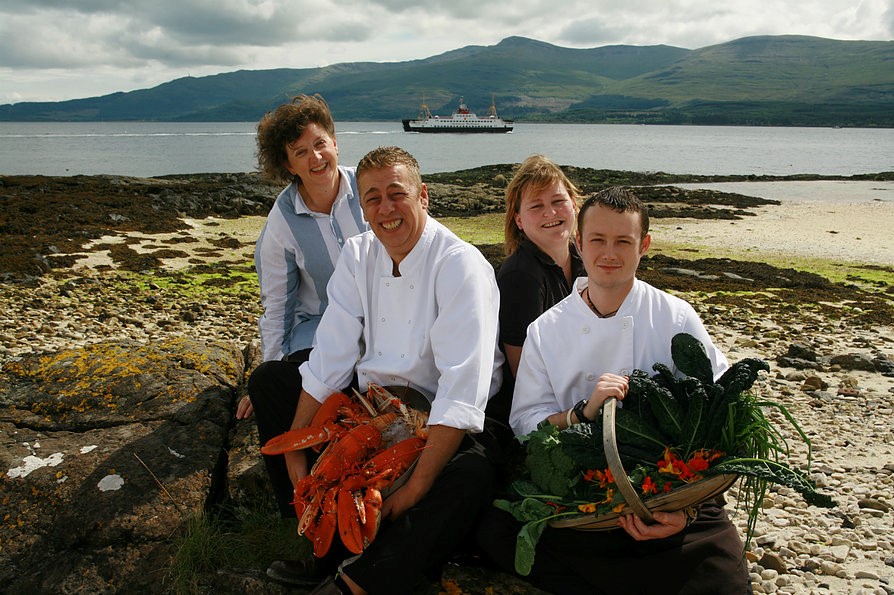Paul McLean at Whitehouse
Would you just look at those fine examples of Scottish seafood and veg, all local by the way. That’s the Isle of Mull in the background, all you see here is Maclean country!
Well he played his trump card here, a special invitation he couldnee resist. Paul likes his seafood and fruit especially, here he could fill his boots with both. Was he intimidated by the name? Not on your nelly, being a McLean he knows he is welcome anywhere in the world, well maybe no a few places in Campbell Argyll. Just look at the photo here of the Whitehouse team, all smiling, even the lobsters have a grin on their faces, “the constantly evolving blackboard menu of local seafood, game and garden produce. Cooking is pleasingly unfussy and flavoursome.” Michelin Guide 2018. “The cooking is very fine indeed” The Good Food Guide 2019. It is produced, carefully sourced, simply served, a daily changing taster menu of up to six courses, menus reflect the seasons and the ingredients foraged and sourced locally. He just didnee want to leave, he does love this part of wild Scotland.
So what are you waiting for? How do you find it? From the Isle of Mull: Take the Calmac Ferry from Fishnish to Lochaline. A five minute walk takes you to The Whitehouse. By car: From Fort William, take the A82 to the Corran Ferry. Take the ferry and turn left onto the A86. After 12 miles turn left for Lochaline . Follow the A884 until you reach Lochaline. The Whitehouse is 50 yards up on the right next to the shop. Telephone 01967 421777 Open Tuesdays to Saturdays for lunch and dinner. Paul’s advice; BOOK. https://www.thewhitehouserestaurant.co.uk
Michael, Head Chef, started out as a coal miner. When the pits shut, he washed pots and slowly worked his way through the ranks in famous restaurants. He then set off around the world. On his return he met Jane and realised that she and Sarah had the same goal: to create a sustainable restaurant using really local food. Jane, a lawyer by day, opened The Whitehouse with Sarah in 2003. She is also a director of the Morvern Community Development Company and a judge in the International Marmalade Competition! Sarah co-owns, and runs Lochaline Stores and is the crew manager for the local volunteer fire service. She has a young family: Archie and Eadie, who regularly help head gardener Lesley. Sarah is a director of the Morvern Community Development Company. Lee started working in his local chip shop where he developed a passion for food. He took off for London’s top restaurants working his way in famous kitchens. He met Mike and joined the Whitehouse.
Why go there what is there to see? Well the short answer is food, lots of glorious Scottish food, best in the world! Spend the day there, wander off to see the castle ruins a wee wander away; 1.5 miles south-east of Lochaline, on minor road on Ardtornish Point, Ardtornish Castle. Any local will happily point out the route. Not much remains of Ardtornish Castle, a 13th or 14th century hall-house, built on a rocky crag. There are foundations of other buildings. This was a property of the MacDonalds. The laird of MacInnes and five of his sons were murdered here about 1319. John (MacDonald), Lord of the Isles, died at Ardtornish in the 1380s. It was here that John MacDonald, Lord of the Isles and Earl of Ross, signed the treaty of Westminster-Ardtornish in 1461 – by which he, the Earl of Douglas, and Edward IV of England agreed to divide Scotland between them. The plan came to nothing, and James IV had destroyed the Lordship of the Isles by 1493. The castle then passed to the MacLeans of Duart, but was abandoned towards the end of the 17th century. The lands went to the Campbells. Devious ways and devious people the Campbells. Dinnae trust em.
A short drive away another castle, Kinlochaline was in the hands of the MacInnes clan. Although today the site appears remote, in medieval Scotland the lochs and waterways were the highways of the West coast meaning Kinlochaline would have been well connected with the wider region, the site saw regular Viking attacks in the twelfth century. In 1164, faced with ruin from these raids, the MacInnes clan allied themselves with Somerled and remained associated with his descendants, the MacDonalds Lords of the Isles, for two hundred years. However, in 1368 a bitter feud started when John MacDonald ordered his kinsman, Donald MacLean, to murder the MacInnes chieftain. Donald duly obeyed and slaughtered both the MacInnes chief and other prominent members of the clan at nearby Ardtornish Castle. Kinlochaline then passed into the hands of the MacLeans and they rebuilt Kinlochaline Castle in the form of a Tower House in the late fifteenth century. The castle was attacked on 7 July 1644 by the forces of the Royalist-Irish General Alasdair MacColla. He had been sent from Ireland to link up with James Graham, Marquis of Montrose in his operations against the Covenanters. He landed on Mull with around 2,000 men and attempted to enlist the support of Sir Lachlan MacLean of Duart Castle. His request for support was ignored. The first site attacked was Kinlochaline Castle which, at that time, was garrisoned by forces of the Covenanter Archibald Campbell, Marquis of Argyll (see, they get everywhere). MacColla detached a force of 400 men under the command of Manus O’Cahan who duly captured and burnt the castle. Kinlochaline Castle was attacked again in 1679, this time by Archibald Campbell, Earl of Argyll (son of the Marquis), as part of a local feud. By the time it was purchased by Sir Alexander Murray in 1730, it had become a roofless ruin. Thereafter the castle stood derelict until the 1890s when efforts were made to restore the site. Extensive rebuilding took place in the late 1990s, including the addition of a building on top of the battlements, and the entire castle has now been converted into a private residence. Sadly you cannee go in.
But you can take the ferry to Mull, now that is a different kettle of fish, another day and another blog; http://mcleanscotland.com/blood-guts-spartans-north/ PAUL MCLEAN, PERTH, SCOTLAND

